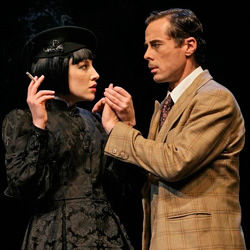Another category is the performance that is well known and for which you have great expectations. (My most memorable example of this it the Lord of the Rings trilogy. I have been a Tolkein fan for decades so walking into The Fellowship of the Ring was a nervous experience - what if they didn't pull it off? I had a similar uneasy experience waling into the theatre for The 39 Steps as I knew that the show had to potential for great entertainment, but also for a real dog's dinner.
I had been aware for some time that the show was based on Hitchcock's 1935 film - with a twist. To realistically portray the film a large cast with many different sets, theatrical effects and costumes are required. A comical take though only requires four actors a few props and "plenty of barefaced cheek". We prepared more carefully for this play that was usual. A week or so before the performance we watched the Hitchcock film. The anticipation of the play made the (silly) 1935 melodrama more interesting as we considered how it was possible to perform the various scenes with only four actors. One particularly intriguing example was the marching band scene.
The director Maria Aitken said that imagining the following back story for the production assisted her in the direction:
... the notion that it is being staged by "a tatty theatre company with a leading man who is determined to play Richard Hannay, but thinks himself much too grand to push the furniture around and a leading lady who's "prepared" to accommodate him by taking all the female roles, and do a little bit of the furniture moving. Rounding out the company are two old-school vaudevillians, determined, in their minds, "to save the play", but sometimes, in their zeal, "inclined to go too far and spoil it".
The hero Richard Hannay is played by Marcus Graham - laconic and affable, with only a touch of the stiff upper lip. Helen Christinson plays the three women in his life - Pamela, Annabella and Margaret - the dark vamp, the cool blonde and the innocent country girl. She moves fluently and convincingly between roles.
 | Graham and Christinson as Hannay and Annabella |
The hundred or so other roles are played by Grant Piro and Tony Taylor. Often they play two or three characters simultaneously, with just a change of hat, accent and facial expression. Sometimes these character changes can be extremely deft requiring brilliant timing. For instance, there is a scene in the hotel in Scotland where hotel manager is about to tell one of the spies about the two heroes in the upstairs room, when his wife comes in to save the day (in the name of romance). This requires three actors on the stage at once, husband, wife and spy, but there are only two actors available to do it. The scene starts with the husband behind the hotel desk talking to the spy. Then the "husband" actor ducks down behind the desk and reappears as the wife (in nightdress) and heads off the spy's questions. The spy actor then leaves the stage and reappears as the husband kilt and all. Another example is in Mr Memory's death scene at the end. Five actors are required, Pamela, Hannay, Mr Memory, the MC and the police inspector. This problem is solved by Taylor playing the MC and policeman at once. He is wearing the MC's dinner jacket but has the policeman's trench coat on his right arm and shoulder. He turns in the appropriate direction, to display the appropriate costume, when playing each part.
Naturally there are many Hitchcock references. The chase across the moor scene is presented as shadow play. It is, of cause, played in exaggerated style when two bi-planes join the search, only to crash. Watching the events from a nearby hill is a little fat Hitchcock figure.
We left this play realising that we had seen another seasonal highlight, along with
Holding the Man and The Season in Sarsparilla.
No comments:
Post a Comment